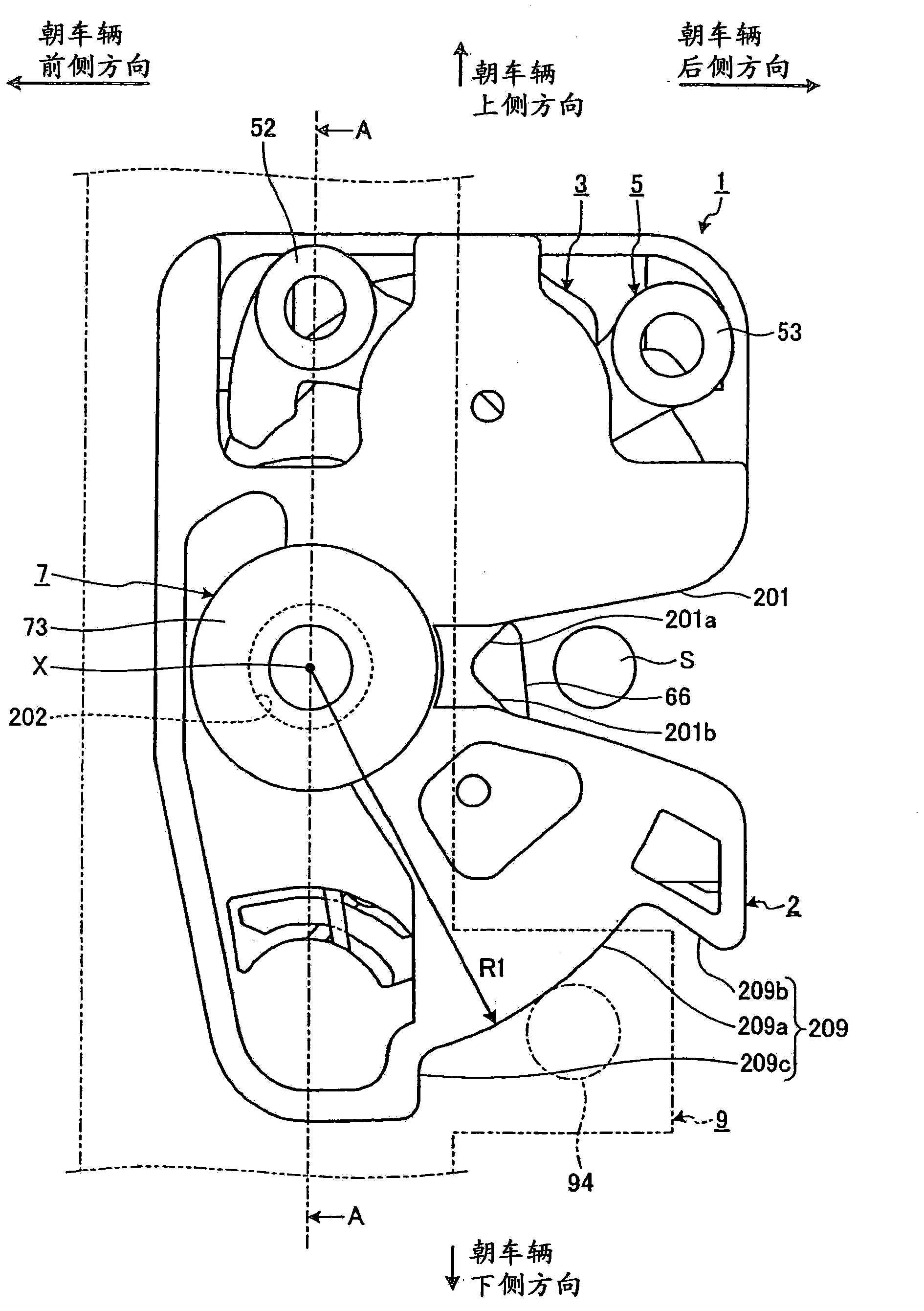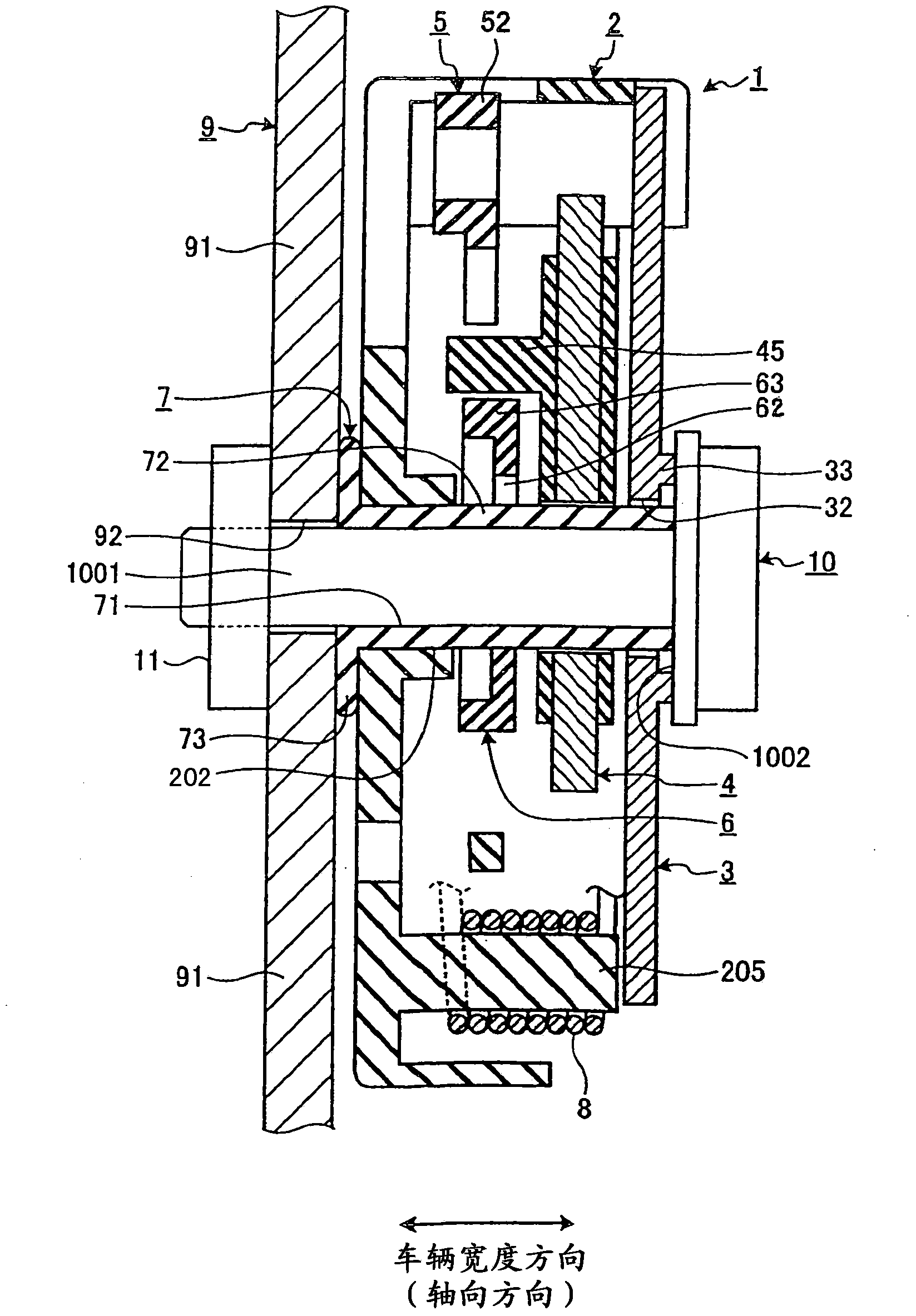Locking device
A technology of locking device and locking mechanism, which is applied in the direction of transportation and packaging, special position of the vehicle, vehicle seat, etc., and can solve the problems that the detachable seat cannot fix the main body of the vehicle, and the striker does not engage with the hook rod, etc.
- Summary
- Abstract
- Description
- Claims
- Application Information
AI Technical Summary
Problems solved by technology
Method used
Image
Examples
no. 1 example
[0031] figure 1 is a plan view showing a schematic structure of the locking device in the first embodiment according to the present invention. figure 2 show figure 1 on the opposite side of the locking mechanism in the image 3 is shown along the line A-A figure 1 cross-sectional view. Figure 4 is a view showing the internal structure of the locking device. Figure 5 is an exploded oblique perspective view showing a structural example of the hook shaft insertion hole formed in the main body portion of the lock device.
[0032] The function of the locking device in the first embodiment is to fix the detachable seat (movable seat) to the vehicle main body (ie, vehicle body). Such a locking device 1 is provided in a detachable seat, connected to a frame 9 (ie, a support) of a backrest part (back support part) of the detachable seat. Such as Figures 1 to 4 As shown, the locking device 1 includes a locking mechanism receiver and a locking mechanism. The locking mechanism...
no. 2 example
[0067] Figure 12 is a plan view showing a schematic structure of a locking device according to a second embodiment of the present invention. Figure 13 yes Figure 12 A cross-sectional view of the , which is at Figure 12 taken along the line B-B in the direction of the arrow.
[0068] In the locking device of the first embodiment, the rotation range of (the main body part 2 of) the locking device 1 is limited by the rotation restricting part 209 of the main body part 2 and the rotation restricting protrusion 94 of the frame 9 . Compared with the first embodiment, in the second embodiment, the rotation range of the locking device 1 is determined by the rotation limiting protrusion 2010 provided on the main body part 2 and the rotation limiting elongated hole (slot hole) 95 provided in the frame 9 restrictions such as Figure 12 with 13 shown. Viewed from the axial direction of the hook lever shaft 7, the rotation restricting elongated hole 55 has a thick circular arc sh...
no. 3 example
[0073] Figure 14 is a sectional view showing a partially schematic structure of a locking device according to a third embodiment of the present invention. Figure 15 is a cross-sectional view showing the Figure 14 The state in which the locking device 1 has been connected to the frame.
[0074] In the locking device according to the first and second embodiments, by making the protruding portion provided on one of the main body portion 2 and the frame 9 contact the engagement portion provided on the other of the main body portion 2 and the frame 9 ( intercepting surface) that prevents rotation of the body part 2 to angles beyond the allowable limits for engagement. Compared to the above, in the locking device according to the third embodiment, when the support bolt 10 is fastened to the nut 11, a pressure load is generated, which increases the rotational resistance between the main body portion 2 and the hook shaft 7. . Thus, the rotation of the main body portion 2 is res...
PUM
 Login to View More
Login to View More Abstract
Description
Claims
Application Information
 Login to View More
Login to View More - R&D
- Intellectual Property
- Life Sciences
- Materials
- Tech Scout
- Unparalleled Data Quality
- Higher Quality Content
- 60% Fewer Hallucinations
Browse by: Latest US Patents, China's latest patents, Technical Efficacy Thesaurus, Application Domain, Technology Topic, Popular Technical Reports.
© 2025 PatSnap. All rights reserved.Legal|Privacy policy|Modern Slavery Act Transparency Statement|Sitemap|About US| Contact US: help@patsnap.com



